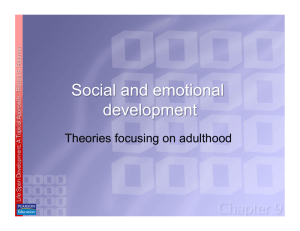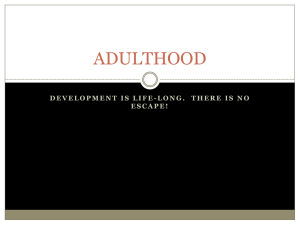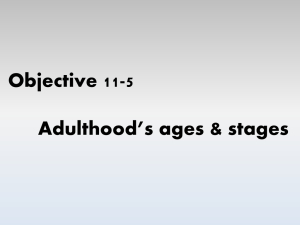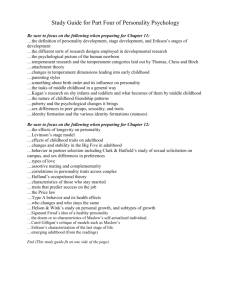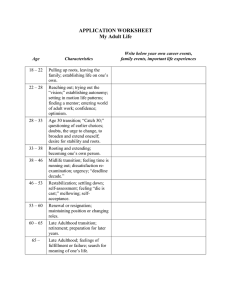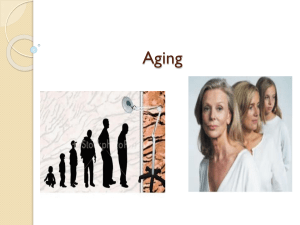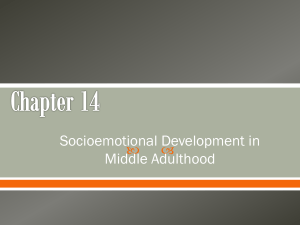Chapter 22: Adulthood: Psychosocial Development Chapter Preview
advertisement
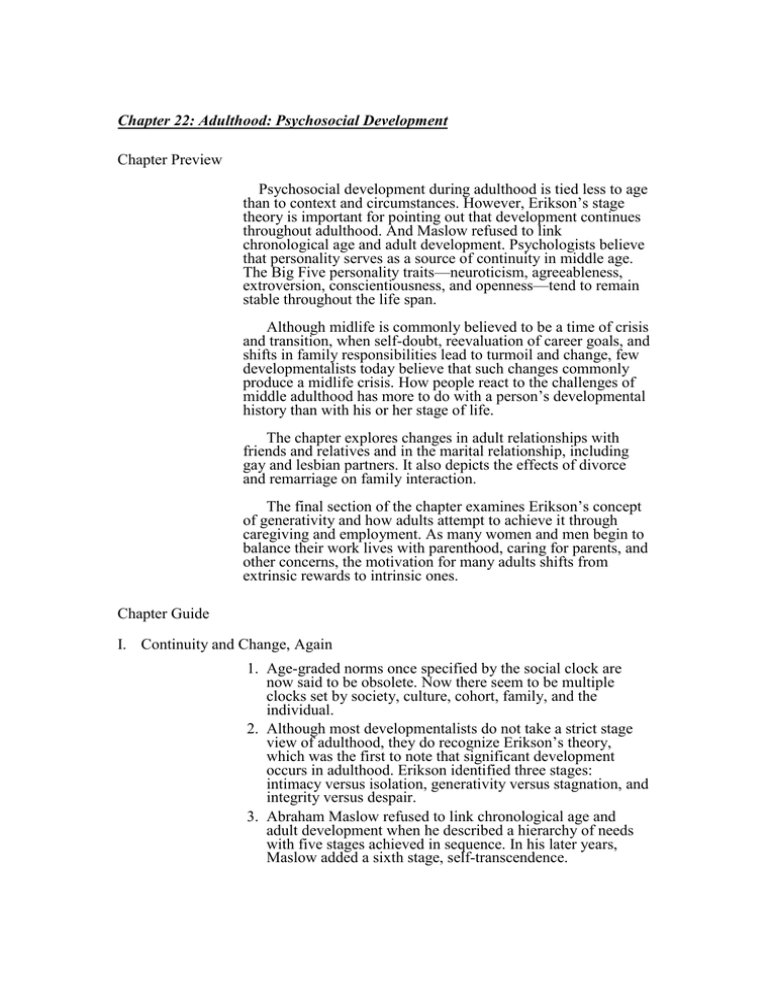
Chapter 22: Adulthood: Psychosocial Development Chapter Preview Psychosocial development during adulthood is tied less to age than to context and circumstances. However, Erikson’s stage theory is important for pointing out that development continues throughout adulthood. And Maslow refused to link chronological age and adult development. Psychologists believe that personality serves as a source of continuity in middle age. The Big Five personality traits—neuroticism, agreeableness, extroversion, conscientiousness, and openness—tend to remain stable throughout the life span. Although midlife is commonly believed to be a time of crisis and transition, when self-doubt, reevaluation of career goals, and shifts in family responsibilities lead to turmoil and change, few developmentalists today believe that such changes commonly produce a midlife crisis. How people react to the challenges of middle adulthood has more to do with a person’s developmental history than with his or her stage of life. The chapter explores changes in adult relationships with friends and relatives and in the marital relationship, including gay and lesbian partners. It also depicts the effects of divorce and remarriage on family interaction. The final section of the chapter examines Erikson’s concept of generativity and how adults attempt to achieve it through caregiving and employment. As many women and men begin to balance their work lives with parenthood, caring for parents, and other concerns, the motivation for many adults shifts from extrinsic rewards to intrinsic ones. Chapter Guide I. Continuity and Change, Again 1. Age-graded norms once specified by the social clock are now said to be obsolete. Now there seem to be multiple clocks set by society, culture, cohort, family, and the individual. 2. Although most developmentalists do not take a strict stage view of adulthood, they do recognize Erikson’s theory, which was the first to note that significant development occurs in adulthood. Erikson identified three stages: intimacy versus isolation, generativity versus stagnation, and integrity versus despair. 3. Abraham Maslow refused to link chronological age and adult development when he described a hierarchy of needs with five stages achieved in sequence. In his later years, Maslow added a sixth stage, self-transcendence. 4. The notion of a midlife crisis at age 40 is not accepted by most developmentalists as an inevitable event during middle age. 5. In pinpointing the reasons for the apparent consistency of some traits, researchers note the importance of genes, culture, parental practices, and adult circumstances. 6. The major source of developmental continuity during adulthood is the stability of personality. Longitudinal, crosssectional, and multicultural research finds five basic clusters of personality traits (the Big Five) that remain quite stable throughout adulthood. These include extroversion, agreeableness, neuroticism, conscientiousness, and openness. 7. The manifestation of these traits is usually stable by early adulthood, when most people have settled into an ecological niche—including vocations, mates, neighborhood, and daily routines—that are compatible with their particular personality needs and interests. 8. The stability of the Big Five personality traits does not mean there are no developmental changes in personality. Certain traits, such as warmth toward others, are particularly likely to reveal interindividual differences. 9. Research has found that of the Big Five traits, agreeableness and conscientiousness increased in adulthood, while openness, extroversion, and neuroticism decreased. 10. One hypothesis is that personality is innate. The opposite hypothesis is that culture affects personality. For example, a possible sixth trait, dependence on others, is particularly significant in Asia but may be considered a psychological disorder by Western psychiatrists. II. Intimacy 1. The group of people with whom we form relationships that guide us through life constitutes our social convoy. Typically, friends are the most supportive members of the social convoy. In addition to these people, neighbors, coworkers, and other consequential strangers often have an impact on our lives. 2. Living arrangements are a poor measure of family closeness. In fact, physical separation does not necessarily weaken family ties, while relationships between parents and adult children are more likely to deteriorate if they live together. 3. Generally, parents are proud of their adult children and provide them more financial and emotional support than the children do for their parents. 4. Siblings tend to be closer in adulthood than in adolescence. Adult siblings help one another cope with children, marriage, and elderly relatives. 5. Specifics of family bonds depend on many factors, including childhood attachments, cultural norms, and the financial and practical resources of each generation. Familism is the belief that family members should care for and support one another at the expense of personal freedom and success. 6. Some adults who are not close to their own families become fictive kin of another family. III. Committed Partners 1. Generally, married people are a little happier, healthier, and wealthier than never-married ones—but not by much. Personal well-being is affected by the quality of the marriage as well as vice versa. Research findings on marital success and satisfaction generally also apply to same-sex partners. 2. Partnerships tend to be happiest in the beginning, then dip when the first child is an infant and dip again when children reach puberty. Gradually, after a decade or two of declining satisfaction, partnerships improve as time goes on. 3. The time in parents’ lives when grown children leave the family home is called the empty nest. Older couples have less child-rearing stress, fewer arguments, and higher incomes than younger couples. 4. In the United States, nearly one out of every two marriages ends in divorce. Divorce is most likely to occur within five years of marriage; cohabitation usually ends even sooner. 5. Divorce in middle adulthood is generally more difficult because it reduces income, severs friendships, weakens family ties, and reduces self-esteem. 6. Initially, remarriage typically brings health, intimacy, and financial security. However, happiness may not endure. IV. Generativity 1. The middle generation, particularly women, tend to be the kinkeepers, maintaining the links between the generations. 2. For most adults, the chief form of generativity involves caring for children. Bearing and rearing children have more costs than benefits when children are young. However, most adults choose to pay that price. 3. About one-third of all North American adults will become stepparents, adoptive parents, or foster parents at some point in their lives. Strong bonds between parent and child are particularly hard to create when a child has already formed strong attachments to other caregivers. 4. Because they are legally connected to their children for life, adoptive parents have an advantage in establishing bonds with their children. 5. Middle-aged people are sometimes called the sandwich generation because they feel pressured by both younger and older generations. 6. As people age, the intrinsic rewards of work tend to become more important than the extrinsic rewards. 7. Today, advanced nations are shifting from industry-based economies to information and service economies. Poorer nations are shifting from subsistence agriculture to industry. 8. Developmentalists welcome employee diversity in background, gender, and ethnicity. In the United States, nearly one-half of the civilian labor force is female and nearly one-fourth is of non-European ancestry. 9. In a diverse workplace, skilled mentors are invaluable in helping those who are less experienced perform their jobs. 10. Researchers have begun to explore micro-aggressions that are unnoticed by workers who are members of the majority, yet seem aggressive to minority workers. 11. Job change is increasingly common in adulthood. 12. Losing a job is generally more devastating for older workers for at least three reasons: • Older workers may never have learned the skills required for a new job. • Older workers are paid more. • Older workers find relocation more difficult. 13. Today, shift work is increasingly common in the workplace. 14. One solution to potential conflict between work and family roles is flextime. Another solution is telecommuting, in which employees can work from home and still keep in touch with the office. 15. Today, marriages are fewer, divorces more frequent, employment often stressful, and unemployment even worse. Parenthood also is more diverse today. An estimated 40 percent of children are born to unmarried parents and about 15 percent have halfsiblings. Although adults are confronted with all these challenges, many cope quite well.
